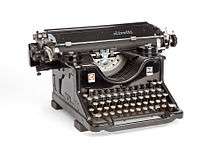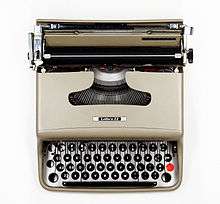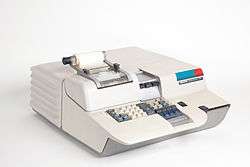Olivetti S.p.A.
Olivetti S.p.A. is an Italian manufacturer of computers, tablets, smartphones, printers and other such business products as calculators and fax machines. Headquartered in Ivrea, in the Metropolitan City of Turin, the company has been part of the Telecom Italia Group since 2003.[2] One of the first commercial programmable desktop calculators, the Programma 101, was produced by Olivetti in 1964 and was a commercial success.
 | |
 Olivetti headquarters in Ivrea | |
| Subsidiary | |
| Industry | Information technology |
| Founded | 1908 |
| Founder | Camillo Olivetti |
| Headquarters | , |
Area served | Europe South America |
Key people | Simone Battiferri Chairman Riccardo Delleani CEO |
| Products | personal computers computer printers typewriters calculators microsystems photocopiers computer peripherals hardware |
| Revenue | €227 million (2014)[1] |
Number of employees | 582 (2014)[1] |
| Parent | Telecom Italia |
| Website | olivetti.it |
History
Founding

The company was founded as a typewriter manufacturer by Camillo Olivetti in 1908 in Ivrea, Italy. The firm was mainly developed by his son Adriano Olivetti. Olivetti opened its first overseas manufacturing plant in 1930, and its Divisumma electric calculator was launched in 1948. Olivetti produced Italy's first electronic computer, the transistorised Elea 9003, in 1959, and purchased the Underwood Typewriter Company that year. In 1964 the company sold its electronics division to the American company General Electric. It continued to develop new computing products on its own; one of these was Programma 101, one of the first commercially produced programmable calculators.[3][4][5] In the 1970s and 1980s they were the biggest manufacturer for office machines in Europe and 2nd biggest PC vendor behind IBM in Europe.
In 1980, Olivetti began distributing in Indonesia through Dragon Computer & Communication.
In 1981, Olivetti installed the electronic voting systems for the European Parliament in Strasburg and Luxembourg.[6]
In September 1994, the company launched Olivetti Telemedia chaired by Elserino Piol.[7]
Since 2003, Olivetti has been part of the TIM Group.
Design


Olivetti was famous for the attention it gave to design:
[A] preoccupation with design developed into a comprehensive corporate philosophy, which embraced everything from the shape of a space bar to the color scheme for an advertising poster.
— Jonathan Martin, International Directory of Company Histories
In 1952, the Museum of Modern Art held an exhibit titled "Olivetti: Design in Industry"; today, many Olivetti products are still part of the museum's permanent collection. Another major show, mounted by the Musée des Arts Décoratifs in Paris in 1969, toured five other cities.[8] Olivetti was also renowned for the caliber of the architects it engaged to design its factories and offices, including Le Corbusier, Louis Kahn, Gae Aulenti, Egon Eiermann, Figini-Pollini, Ignazio Gardella, Carlo Scarpa, BBPR, and many others.[9]
From the 1940s to the 1960s, Olivetti industrial design was led by Marcello Nizzoli, responsible for the Lexicon 80 (1948) and the portable Lettera 22 (1950). Later, Mario Bellini and Ettore Sottsass directed design.[10] Bellini designed the Programma 101 (1965), Divisumma 18 (1973) and Logos 68 (1973) calculators and the TCV-250 video display terminal (1966), among others. Sottsass designed the Tekne 3 typewriter (1958), Elea 9003 computer (1959), the Praxis 48 typewriter (1964), the Valentine portable typewriter (1969), and others. Michele De Lucchi designed the Art Jet 10 inkjet printer (1999) (winner of the Compasso d'Oro) and the Gioconda calculator (2001).[11] During the 1970s Olivetti manufactured and sold two ranges of minicomputers. The 'A' series started with the typewriter-sized A4 through to the large A8, and the desk-sized DE500 and DE700 series. George Sowden worked for Olivetti from 1970 until 1990, and designed their first desktop computer, Olivetti L1, in 1978 (following ergonomic research lasting two years). In 1991, Sowden won the prestigious ADI Compasso d'Oro Award for the design of the Olivetti fax OFX420.
Olivetti paid attention to more than product design; graphic and architectural design was also considered pivotal to the company. Giovanni Pintori was hired by Adriano Olivetti in 1936 to work in the publicity department. Pintori was the creator of the Olivetti logo and many promotional posters used to advertise the company and its products. During his activity as Art Director from 1950, Olivetti's graphic design obtained several international awards, and he designed works that created the Olivetti image and became emblematic Italian reference in the history of 20th-century design.[12]
Those designers also created the Olivetti Synthesis office furniture series which mainly were used to be installed in the firm's own headquarters, worldwide branch offices and showrooms. Olivetti also produced some industrial production machinery, including metalworking machines of the Horizon series.
Typewriters
Olivetti began with mechanical typewriters when the company was founded in 1909, and produced them until the mid-1990s. Until the mid-1960s, they were fully mechanical, and models such as the portable Olivetti Valentine were designed by Ettore Sottsass.
With the Tekne/Editor series and Praxis 48, some of the first electromechanical typewriters were introduced. The Editor series was used for speed typing championship competition. The Editor 5 from 1969 was the top model of that series, with proportional spacing and the ability to support justified text borders. In 1972 the electromechanical typeball machines of the Lexicon 90 to 94C series were introduced, as competitors to the IBM Selectric typewriters, the top model 94c supported proportional spacing and justified text borders like the Editor 5, as well as lift-off correction.
In 1978 Olivetti was one of the first manufacturers to introduce electronic daisywheel printer-based word processing machines called TES 401 and TES 501. Later the ET series typewriters without (or with) LCD and different levels of text editing capabilities were popular in offices. Models in that line were ET 121, ET 201, ET 221, ET 225, ET 231, ET 351, ET 109, ET 110, ET 111, ET 112, ET 115, ET 116, ET 2000, ET 2100, ET 2200, ET 2250, ET 2300, Et 2400 and ET 2500. For home users in 1982 the Praxis 35, Praxis 40 and 45D were some of the first portable electronic typewriters. Later, Olivetti added the Praxis 20, ET Compact 50, ET Compact 60, ET Compact 70, ET Compact 65/66, the ET Personal series and Linea 101. The top models were 8 lines LCD based portables like Top 100 and Studio 801, with the possibility to save the text to a 3.5-inch floppy disk.
The professional line was upgraded with the ETV series video typewriters based on CP/M operating system, ETV 240, ETV 250, ETV 300, ETV 350 and later MS-DOS operating system based ETV 260, ETV 500, ETV 2700, ETV 2900, ETV 4000s word processing systems having floppy drives or hard disks. Some of them (ETV 300, 350, 500, 2900) were external boxes that could be connected through an optional serial interface to many of the ET series office typewriters, the others were fully integrated with an external monitor which could be installed on a holder over the desk. Most of the ET/ETV/Praxis series electronic typewriters were designed by Marion Bellini.
By 1994, Olivetti stopped production of typewriters, as most users had transitioned to Personal Computers.
Computers




Between 1955 and 1964 Olivetti developed some of the first transistorized mainframe computer systems, such as the Elea 9003. Although 40 large commercial 9003 and over 100 smaller 6001 scientific machines were completed and leased to customers to 1964, low sales, loss of two key managers and financial instability caused Olivetti to withdraw from the field in 1964.
In 1965 Olivetti released the Programma 101, considered one of the first commercial desktop programmable calculators. It was saved from the sale of the computer division to GE thanks to an employee, Gastone Garziera, who spent successive nights changing the internal categorization of the product from "computer" to "calculator", so leaving the small team in Olivetti and creating some awkward situations in the office, since that space was now owned by GE.[13] In 1974 the firm released the TC800, an intelligent terminal designed to be attached to a mainframe and used in the finance sector. It was followed in 1977 by the TC1800.
Olivetti's first modern personal computer, the M20, featuring a Zilog Z8000 CPU, was released in 1982. In 1983 the firm introduced the M24, a clone of the IBM PC using DOS and the Intel 8086 processor (at 8 MHz) instead of the Intel 8088 used by IBM (at 4.77 MHz). The M24 was sold in North America as the AT&T 6300. Olivetti also manufactured the AT&T 6300 Plus, which could run both DOS and Unix.[14] The M24 in the US also was sold as Xerox 6060. The M28 was the firm's first PC to have the Intel 80286 processor.
In 1983 Olivetti produced its M10 laptop computer, a 8085-based workalike of the successful Radio Shack TRS-80 Model 100, which it marketed in Europe.[15] These were the first laptops to sell in million-unit quantities, though the Olivetti M10 itself only attained sales figures in the tens of thousands and went out of production within two years.
In 1985 the company acquired a controlling share in the British computer manufacturer Acorn Computers Ltd; a third partner was Thomson SA. Olivetti sold the Thomson MO6 and Acorn BBC Master Compact with brand names Olivetti Prodest PC128 and PC128s respectively. At the same time, Olivetti also tried to compete with de: Schneider Euro PC with the MS-DOS-based Prodest PC1, but without success.
In 1987 Olivetti introduced the LSX line of computers which was based on the Motorola 68k processor. They could run either MOS or Olivetti's Unix, X/OS.[16] In 1989 Olivetti introduced the 80486 based next generation of LSX workstations with the LSX 5020 with EISA-Bus, it was shown in CeBit 1989 as "Computing Platform CP486".
In 1990, Olivetti had its own distribution network in New Zealand through Essentially Software Ltd.[17] (owned by Gary McNabb) located at Mt. Eden in Auckland and Wellington, where an Olivetti M300-100 16 MHz PCs with 80386SX CPU were sold for NZ$7395 and used as graphical work station for design houses using Corel Draw as graphical program. The New Zealand distribution stopped in 1991 when Olivetti could not supply their PCs.
Olivetti also sold quasi-portable 8086/8088-based PCs with an integrated keyboard and one or two integrated 3.5" floppy disk drives, running DOS 3.27, an Olivetti OEM version of PC DOS 3.20 with minor improvements like the M21 portable (based on M24) and the M15. Also later Olivetti produced interesting laptops like M111, M211, S20, D33, Philos and Echos series. A very interesting subnotebook was the Olivetti Quaderno, about the same size as an A5 paper – it was the grandfather of the netbooks introduced 20 years later.
End of computer production
Olivetti did attempt to recover its position by introducing the Envision in 1995,[18] a full multimedia PC, to be used in the living room; this project was a failure. Packard Bell managed to successfully introduce a similar product in the U.S. but only some years later. The main problem of the company was its inability to conjugate innovation with the quality standards it had committed itself to, at a time when the margins on the PC market were diminishing as not only the market but also the number of PC clone producers grew. The company continued to develop personal computers until it sold its PC business in 1997.
Peripherals
- PR40, PR2, PR2-e, PR2+, PR2-10 Scanner Printer which was used in banking sectors
- PG-series and PGL-series - black and white digital printers
- d-Color p-series color digital printers
- A3 and A4 series MFP
End of Olivetti as a separate company
In the 1990s, Olivetti's computer businesses were in great difficulty, reportedly because of the competition from US vendors and new cheap manufacturers for PC components in Taiwan like ASUS, MSI, Gigabyte and so on from which local system builders profited much to offer cheaper PCs than Olivetti did with their own designs. It was on the brink of collapse and had needed government support to stay afloat. A company in transition, it had moved out of the typewriter business into personal computers before embracing telecoms between 1997 and 1999. In the process it had lost around three-quarters of its staff.
In 1999, The Luxembourg-based company Bell S.A. acquired a controlling stake in Olivetti, but sold it to a consortium including the Pirelli and Benetton groups two years later. Olivetti then launched a hostile bid for Telecom Italia in February 1999, despite being less than a seventh of the size of its target. In a take-over battle against Deutsche Telekom, and other potential bidders, Olivetti won out and controlled 52.12% of former monopoly Telecom Italia, Italy's #1 fixed-line and mobile phone operator. However, the ownership structure of the merged Olivetti / Telecom Italia was complex and multi-layered with Olivetti took on around $16 billion of extra debt. It was then referred to as the "Olivetti/Telecom Italia affair" because of the unpleasant secret affairs behind.
After a 2003 reorganization, Olivetti became the office equipment and systems services subsidiary of Telecom Italia. In 2003 Olivetti was absorbed into the Telecom Italia group, maintaining a separate identity as Olivetti Tecnost.
Rebirth and resumption of computer production
In 2005, Telecom Italia relaunched the company in the information technology sector, investing €200 million; at first, restoring the original Olivetti brand, then replacing it with Olivetti Tecnost in 2003. In 2007, Olivetti launched the "LINEA_OFFICE", designed by Jasper Morrison for Olivetti; a new line of PCs, notebooks, printers, fax machines and calculators. Olivetti today operates in Italy and Switzerland, and has sales associates in 83 countries. Research and development are located in Agliè, Carsoli and Scarmagno in Italy, and Yverdon, Switzerland.
In March 2011 Olivetti began producing the OliPad, its first tablet computer, featuring a ten-inch screen, 3G, WiFi, Bluetooth connectivity, Nvidia Tegra 2, Android 2.2.2 and a 1024 x 600 display. It also features an application store, with apps specifically designed by Olivetti for 'business & government'.[19] In 2014 the R&D department in Arnad was sold to SICPA.[20]
Smartphones
In 2013, Olivetti launched a series of smartphones called Oliphone:[21]
- Olivetti Oliphone M8140
- Olivetti Oliphone Q8145
- Olivetti Oliphone Q8150
- Olivetti Oliphone Q9047
- Olivetti Oliphone WG451
- Olivetti Oliphone WG501
See also
- List of Italian companies
References
- "Olivetti: The Company". Olivetti S.p.A. Archived from the original on 2016-04-23.
- "Olivetti SpA", Profile, Hoovers
- "Olivetti Programma 101 Electronic Calculator". The Old Calculator Web Museum.
technically, the machine was a programmable calculator, not a computer.
- "2008/107/1 Computer, Programma 101, and documents (3), plastic / metal / paper / electronic components, hardware architect Pier Giorgio Perotto, designed by Mario Bellini, made by Olivetti, Italy, 1965-1971". www.powerhousemuseum.com. Retrieved 2016-03-20.
- "Olivetti Programma 101 Electronic Calculator". The Old Calculator Web Museum.
It appears that the Mathatronics Mathatron calculator preceeded the Programma 101 to market.
- "European Parliament electronic voting system". Retrieved August 26, 2019 – via www.youtube.com.
- Ramu, S. Shiva (1999). Cyberspace & Repositioning Of Corporations. Universities Press. ISBN 9788173710384.
- Woodham, Jonathan (1997). Twentieth Century Design. Oxford: Oxford University Press. p. 160. ISBN 0-19-284204-8.
- Nathan H. Shapira, Renzo Zorzi, Design Process: Olivetti 1908–1978, catalogue of a show at the Frederick S. Wight Art Gallery of UCLA, 1979.
- Walker, John. (1992) "Olivetti". Glossary of Art, Architecture & Design since 1945, 3rd. ed.
- "History & Culture Photo Archive". Telecom Italia. Archived from the original on 2008-04-07. Retrieved 2008-04-22.
- Musina, Massimiliano. (2014) Giovanni Pintori. The Stark Tension Between Flair and Discretion. Bologna: Fausto Lupetti Editore.
- "Programma 101 Memory of the Future: Quando Olivetti Inventò il PC" [When Olivetti invented the PC] (Google You tube). History Channel (in Italian). June 26, 2011.
- InfoWorld (Google Books). 1986-12-01. Retrieved 2012-03-10.
- "The Olivetti M10". Yet Another Computer Museum. fjkraan.
- "Uncle Miod's machineroom". Retrieved 2012-12-02.
- Software spectrum acquires Australia, New Zealand supplier of PC… (article), The free library.
- "Olivetti Envision". Ultimate Console Database. Retrieved 2012-03-10.
- "Olivetti launches OliPad tablet, second coming of the typewriter?". Mar 6, 2011. Retrieved 2011-03-06.
- "SICPA". SICPA. Retrieved 2020-03-13.
- "Telefoni e Smartphone" [Telephones & smartphones] (in Italian). Olivetti.
External links
| Wikimedia Commons has media related to Olivetti. |
- Official website
- History of Olivetti at Telecom Italia (archived 2005)
- Picture of a 1983 office featuring an Olivetti M24
- "Olivetti Poster, a work of art". Victoria and Albert Museum. Retrieved 2007-11-19.
- "History of Olivetti" - SEQ Corporation, Stockholm, Sweden
- Video Olivetti L1 M40 ST Retro Computer museum, Zatec, Czech Republic video
- Video Olivetti P6066 Retro Computer museum, Zatec, Czech Republic video